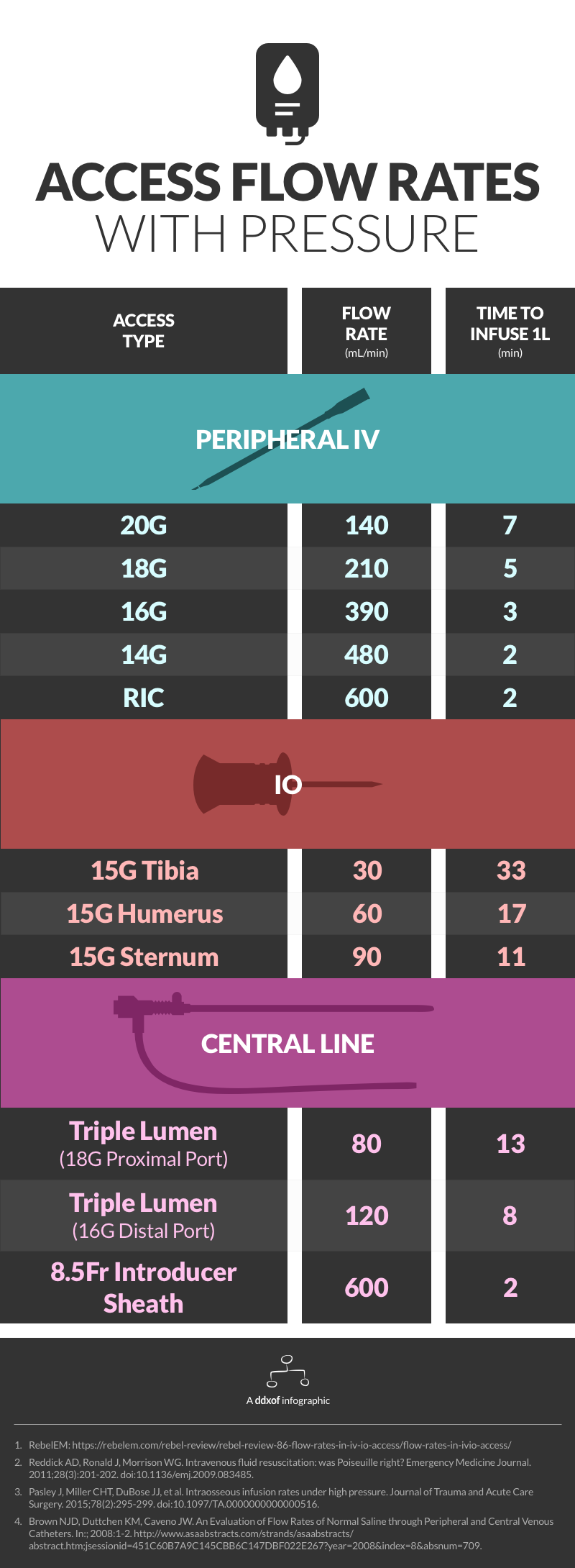Notes
Data on access flow rates are highly variable. This infographic uses flow rates achieved through dedicated rapid infusers (ex. Level 1 ®) or at a pressure of 300mmHg. It is possible that rapid infusers and specialized pressure tubing achieve higher flow rates. The main references and additional sources are listed below. See this post from REBEL EM for gravity flow rates.
References
- Reddick AD, Ronald J, Morrison WG. Intravenous fluid resuscitation: was Poiseuille right? Emergency Medicine Journal. 2011;28(3):201-202. doi:10.1136/emj.2009.083485.
- Pasley J, Miller CHT, DuBose JJ, et al. Intraosseous infusion rates under high pressure. Journal of Trauma and Acute Care Surgery. 2015;78(2):295-299. doi:10.1097/TA.0000000000000516.
- Brown NJD, Duttchen KM, Caveno JW. An Evaluation of Flow Rates of Normal Saline through Peripheral and Central Venous Catheters. In:; 2008:1-2. http://www.asaabstracts.com/strands/asaabstracts/abstract.htm;jsessionid=451C60B7A9C145CBB6C147DBF022E267?year=2008&index=8&absnum=709.
Additional Sources
- Ngo AS-Y, Oh JJ, Chen Y, Yong D, Ong MEH. Intraosseous vascular access in adults using the EZ-IO in an emergency department. Int J Emerg Med. 2009;2(3):155-160. doi:10.1007/s12245-009-0116-9.
- Traylor S, Bastani A, Emergency NB-DAO, 2016. 311 Are Three Ports Better Than One? an Evaluation of Flow Rates Using All Ports of a Triple Lumen Central Venous Catheter in Volume Resuscitation. doi:10.1016/j.annemergmed.2016.08.327.
- Hammer N, Möbius R, Gries A, Hossfeld B, Bechmann I, Bernhard M. Comparison of the Fluid Resuscitation Rate with and without External Pressure Using Two Intraosseous Infusion Systems for Adult Emergencies, the CITRIN (Comparison of InTRaosseous infusion systems in emergency medicINe)-Study. Raju R, ed. PLoS ONE. 2015;10(12):e0143726–15. doi:10.1371/journal.pone.0143726.
- Ong MEH, Chan YH, Oh JJ, Ngo AS-Y. An observational, prospective study comparing tibial and humeral intraosseous access using the EZ-IO. Am J Emerg Med. 2009;27(1):8-15. doi:10.1016/j.ajem.2008.01.025.
- Philbeck TE, Miller LJ, Montez D, Puga T. Hurts so good. Easing IO pain and pressure. JEMS. 2010;35(9):58–62–65–6–68–quiz69. doi:10.1016/S0197-2510(10)70232-1.
- FRCA SIK, MRCA PRG, FRCA KP, MBChB SW, FRCA TS, MRCP PRG. Flow rates through intravenous access devices: an in vitro study. J Clin Anesth. 2016;31:101-105. doi:10.1016/j.jclinane.2016.01.048.
- Puga T, Montez D, Care TPC, 2016. 263: ADEQUACY OF INTRAOSSEOUS VASCULAR ACCESS INSERTION SITES FOR HIGH-VOLUME FLUID INFUSION. journalslwwcom
- Tan BKK, Chong S, Koh ZX, Ong MEH. EZ-IO in the ED: an observational, prospective study comparing flow rates with proximal and distal tibia intraosseous access in adults. Am J Emerg Med. 2012;30(8):1602-1606. doi:10.1016/j.ajem.2011.10.025.


Pingback: Best of FOAMed - October 2019 • The BREACH